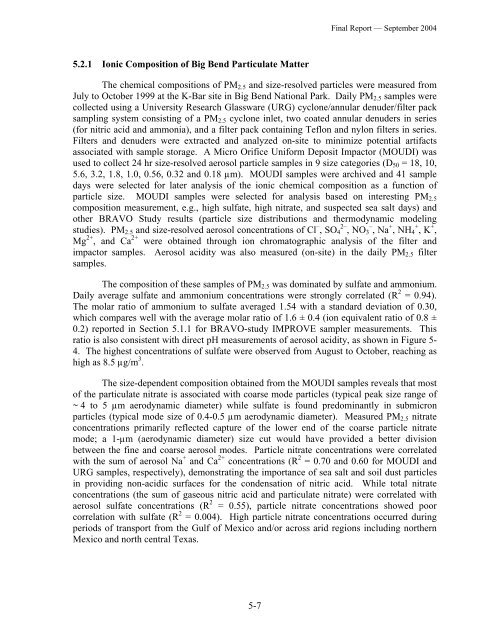(BRAVO) Study: Final Report. - Desert Research Institute
(BRAVO) Study: Final Report. - Desert Research Institute
(BRAVO) Study: Final Report. - Desert Research Institute
Create successful ePaper yourself
Turn your PDF publications into a flip-book with our unique Google optimized e-Paper software.
<strong>Final</strong> <strong>Report</strong> — September 2004<br />
5.2.1 Ionic Composition of Big Bend Particulate Matter<br />
The chemical compositions of PM 2.5 and size-resolved particles were measured from<br />
July to October 1999 at the K-Bar site in Big Bend National Park. Daily PM 2.5 samples were<br />
collected using a University <strong>Research</strong> Glassware (URG) cyclone/annular denuder/filter pack<br />
sampling system consisting of a PM 2.5 cyclone inlet, two coated annular denuders in series<br />
(for nitric acid and ammonia), and a filter pack containing Teflon and nylon filters in series.<br />
Filters and denuders were extracted and analyzed on-site to minimize potential artifacts<br />
associated with sample storage. A Micro Orifice Uniform Deposit Impactor (MOUDI) was<br />
used to collect 24 hr size-resolved aerosol particle samples in 9 size categories (D 50 = 18, 10,<br />
5.6, 3.2, 1.8, 1.0, 0.56, 0.32 and 0.18 µm). MOUDI samples were archived and 41 sample<br />
days were selected for later analysis of the ionic chemical composition as a function of<br />
particle size. MOUDI samples were selected for analysis based on interesting PM 2.5<br />
composition measurement, e.g., high sulfate, high nitrate, and suspected sea salt days) and<br />
other <strong>BRAVO</strong> <strong>Study</strong> results (particle size distributions and thermodynamic modeling<br />
studies). PM 2.5 and size-resolved aerosol concentrations of Cl – , SO 2– 4 , NO – 3 , Na + , NH + 4 , K + ,<br />
Mg 2+ , and Ca 2+ were obtained through ion chromatographic analysis of the filter and<br />
impactor samples. Aerosol acidity was also measured (on-site) in the daily PM 2.5 filter<br />
samples.<br />
The composition of these samples of PM 2.5 was dominated by sulfate and ammonium.<br />
Daily average sulfate and ammonium concentrations were strongly correlated (R 2 = 0.94).<br />
The molar ratio of ammonium to sulfate averaged 1.54 with a standard deviation of 0.30,<br />
which compares well with the average molar ratio of 1.6 ± 0.4 (ion equivalent ratio of 0.8 ±<br />
0.2) reported in Section 5.1.1 for <strong>BRAVO</strong>-study IMPROVE sampler measurements. This<br />
ratio is also consistent with direct pH measurements of aerosol acidity, as shown in Figure 5-<br />
4. The highest concentrations of sulfate were observed from August to October, reaching as<br />
high as 8.5 µg/m 3 .<br />
The size-dependent composition obtained from the MOUDI samples reveals that most<br />
of the particulate nitrate is associated with coarse mode particles (typical peak size range of<br />
~ 4 to 5 µm aerodynamic diameter) while sulfate is found predominantly in submicron<br />
particles (typical mode size of 0.4-0.5 µm aerodynamic diameter). Measured PM 2.5 nitrate<br />
concentrations primarily reflected capture of the lower end of the coarse particle nitrate<br />
mode; a 1-µm (aerodynamic diameter) size cut would have provided a better division<br />
between the fine and coarse aerosol modes. Particle nitrate concentrations were correlated<br />
with the sum of aerosol Na + and Ca 2+ concentrations (R 2 = 0.70 and 0.60 for MOUDI and<br />
URG samples, respectively), demonstrating the importance of sea salt and soil dust particles<br />
in providing non-acidic surfaces for the condensation of nitric acid. While total nitrate<br />
concentrations (the sum of gaseous nitric acid and particulate nitrate) were correlated with<br />
aerosol sulfate concentrations (R 2 = 0.55), particle nitrate concentrations showed poor<br />
correlation with sulfate (R 2 = 0.004). High particle nitrate concentrations occurred during<br />
periods of transport from the Gulf of Mexico and/or across arid regions including northern<br />
Mexico and north central Texas.<br />
5-7
















